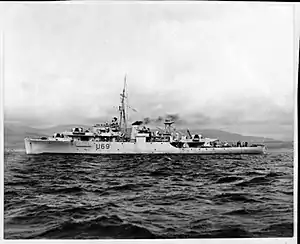HMS Redpole (U69)
HMS Redpole was a modified Black Swan-class sloop of the Royal Navy. She was laid down by Yarrow Shipbuilders Limited, Scotstoun on 18 May 1942, launched on 25 February 1943 and commissioned on 24 June 1943, with the pennant number U69.[1]
 HMS Redpole anchored in 1943. | |
| History | |
|---|---|
| Name: | Redpole |
| Namesake: | Redpole |
| Ordered: | 27 March 1941 |
| Builder: | Cammell Laird, Birkenhead |
| Laid down: | 18 May 1942 |
| Launched: | 25 February 1943 |
| Commissioned: | 24 June 1943 |
| Decommissioned: | 1958 |
| Identification: | Pennant number: U69 |
| Fate: | Scrapped in 1960 |
| General characteristics | |
| Class and type: | Modified Black Swan-class sloop |
| Displacement: | 1,350 tons |
| Length: | 283 ft (86 m) |
| Beam: | 38.5 ft (11.7 m) |
| Propulsion: |
|
| Speed: | 20 knots (37 km/h) at 4,300 hp (3,200 kW) |
| Complement: | 192 men + 1 Cat |
| Armament: |
|
Construction and career
After tests and its operational commissioning in July 1943, HMS Redpole joined the 7th Escort Group in Greenock for the escort and support of convoys in the Atlantic, then in Gibraltar, for convoys in the Mediterranean.
In May 1944, she was in the service of Support Force G during the assault phase of the Allied landing planned in Normandy as part of Operation Neptune.
At the end of 1944, Redpole was assigned to the East Indies Fleet for training when some ships were transferred to the British Pacific Fleet.
In January 1945, she joined Task Force 64 to support the landings in Burma. She provided fire support with the Bombardment Force during the landings of the British 4th and 71st Brigades in the northern part of Ramree Island during Operation Matador.
From February to July 1945, she was in Auckland, New Zealand for repairs and technical improvements. At the end of the post-refit tests, she left for Sydney, Australia for service with the British Pacific Fleet, then found himself at Manus Forward Operating Base in the Admiralty Islands in August 1945.
HMS Redpole returned to Royal Navy control upon arrival and deployed with the British Pacific Fleet to Hong Kong to support repatriation operations. She remained in the Pacific until his return to the United Kingdom in 1946 to be placed on the reserve at Harwich.
Three years later, the vessel was reactivated to serve as a navigation training vessel attached to HMS Dryad in Portsmouth and returned to service. Its armament was removed during a major refit, including the installation of a tripod mast and the provision of facilities for the practical training of junior officers in navigation.
On 12 July 1957 he was involved in a collision with the Gosport Ferry Vadne ferry, killing 40 passengers and seriously damaging the ferry.
In 1958 the ship was withdrawn from its training role and returned to the reserve until 1960.
It was sold to BISCO on 11 November 1960 for demolition by JA White and arrived in tow at the demolition site in Saint-Davids on 20 November that year.[2]
References
- "HMS Redpole (U 69) of the Royal Navy - British Sloop of the Modified Black Swan class - Allied Warships of WWII - uboat.net". uboat.net. Retrieved 21 October 2020.
- "HMS Redpole, sloop". www.naval-history.net. Retrieved 21 October 2020.
Further readings
- Blackman, Raymond V. B. (1971). Jane's Fighting Ships 1971–72. London: Sampson Low, Marston & Company. ISBN 0-354-00096-9.
- Blair, Clay Gardiner (2000). Hitler's U-Boat War: The Hunted 1942–1945. Vol. 3. New York: Modern Library. ISBN 0-679-64033-9.
- Gardiner, Robert Gardiner (1980). Conway's All the World's Fighting Ships (1922-1946). Vol. 3. Conway Maritime Press. p. 456. ISBN 0-85177-146-7.
- Gardiner, Robert Gardiner (1996). Conway's All the World's Fighting Ships (1947-1995). Vol. 4. US Naval Institute Press. p. 675. ISBN 1-55750-132-7.
- Colledge, J. J.; Warlow, Ben (2006) [1969]. Ships of the Royal Navy: The Complete Record of all Fighting Ships of the Royal Navy (Rev. ed.). London: Chatham Publishing. ISBN 978-1-86176-281-8.
- Hague, Arnold (1993). Sloops: A History of the 71 Sloops Built in Britain and Australia for the British, Australian and Indian Navies 1926–1946. Kendal, England: World Ship Society. ISBN 0-905617-67-3.